With an established reputation for quality and high-end performance, Japanese optical systems are held in high regard, so we received the new Japanese-designed Founder Optics FOT106 triplet refractor for review with keen anticipation.
The telescope is supplied in an aluminium case with useful accessories and our package included a matching field-flattener.
From the outset we were impressed with the overall look of the telescope; the refractor is finished to a very high standard, with a distinctive gloss black tube and vibrant metallic green anodising for the fittings.
We also noted that it weighs a reassuringly chunky 6.7kg thanks to its solid construction.
This telescope is among our pick of the best telescopes for astrophotography
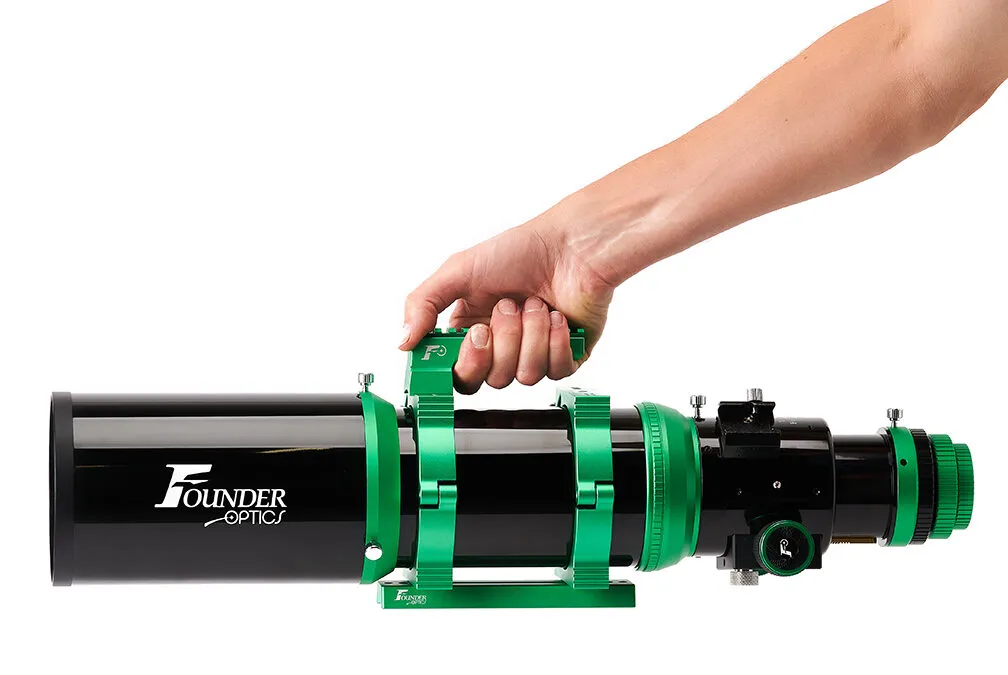
When it comes to optics, the FOT106 boasts an f/6 106mm objective lens with a focal length of 636mm, making it ideal for observing or photographing larger star clusters, galaxies and nebulae.
With the dew shield and focuser retracted the tube assembly is a compact 557mm in length.
With the dew shield fully extended and a field-flattener plus camera – or star diagonal and eyepiece – attached, the telescope’s working length is around 800mm.
Considering that there are three pieces of glass at the working end, it was nice to see that the balance point of the tube was reasonably central. This made it comfortable to use for observing, and easier on a mount for astrophotography.
Despite having the Inspection Report card, we were keen to do our own star test to confirm the findings.
It was a warm evening, so we allowed plenty of time for the telescope to cool. Our Ronchi eyepiece returned an almost identical pattern to that on the report and demonstrated that there was no astigmatism or other glaring optical aberrations.
With a 4.5mm eyepiece working at 140x magnification, and then combined with a 2x Barlow lens to deliver 280x power, we observed a centrally positioned star and gently rolled through either side of focus, noting the star pattern.
If anything, what we observed was even better than the artificial star test image given on the Inspection Report, with a ring pattern demonstrating a high level of correction.
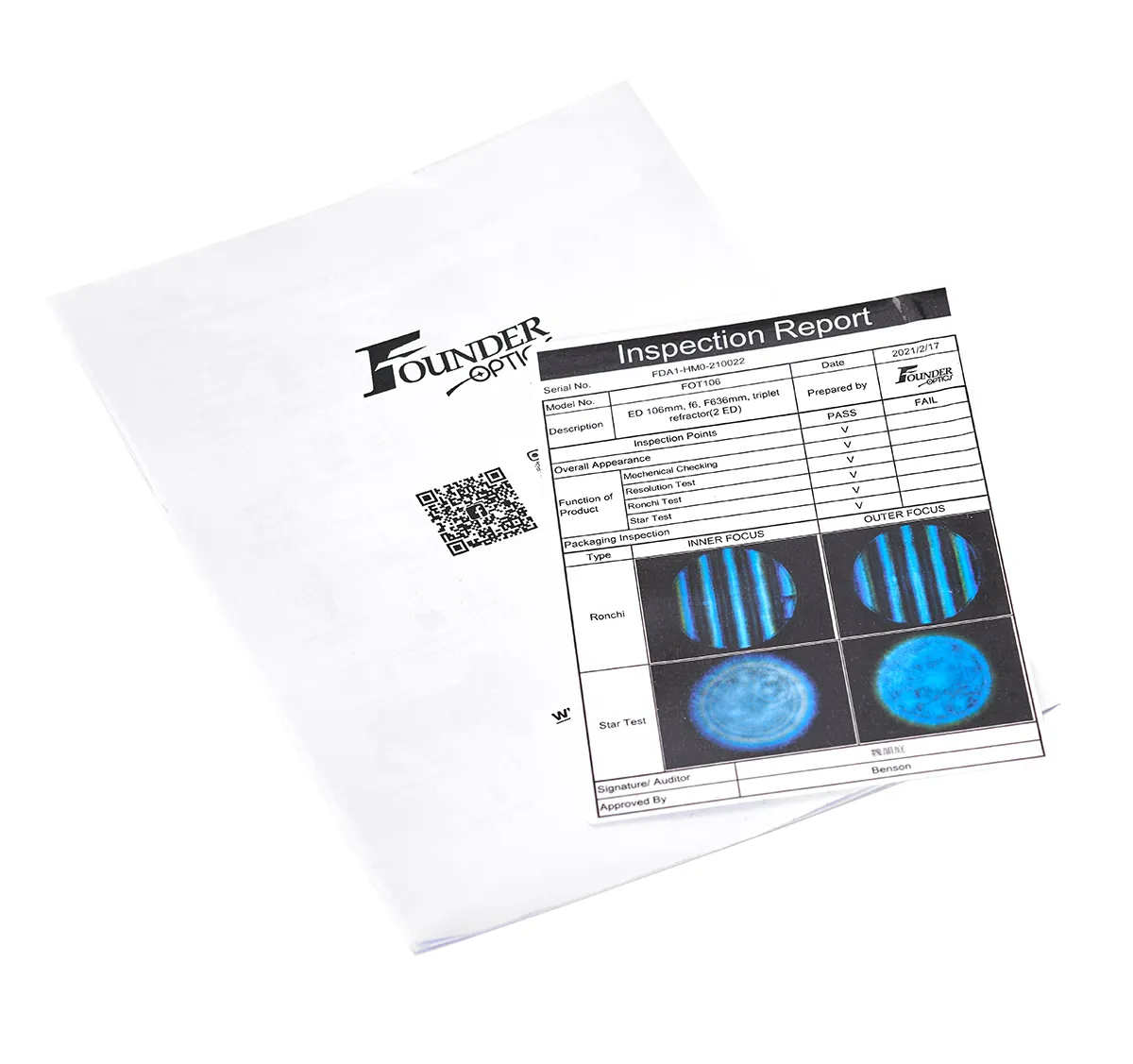
This gave us confidence that the performance of the telescope should be excellent, and a visit to Epsilon (ε) Lyrae, the famous Double Double star, revealed a clean and distinct split between its four closely paired members.
With the FOT106 set up for observing we embarked on a tour of some of our favourite deep-sky objects.
Our 13mm 100° eyepiece enabled us to enjoy some very comfortable viewing at 50x magnification, and with a range of globular clusters gracing the skies we were able to enjoy crisp, contrast-rich views of them in context, before switching to a 10mm eyepiece for a closer view.
An immersive viewing experience with our 21mm 100° eyepiece was especially memorable, with the low magnification of 30x providing superb wide views.
We added a visual OIII (Oxygen) filter to enhance the planetary nebulae M57 and M27, which were notably bright objects among a sea of stars.
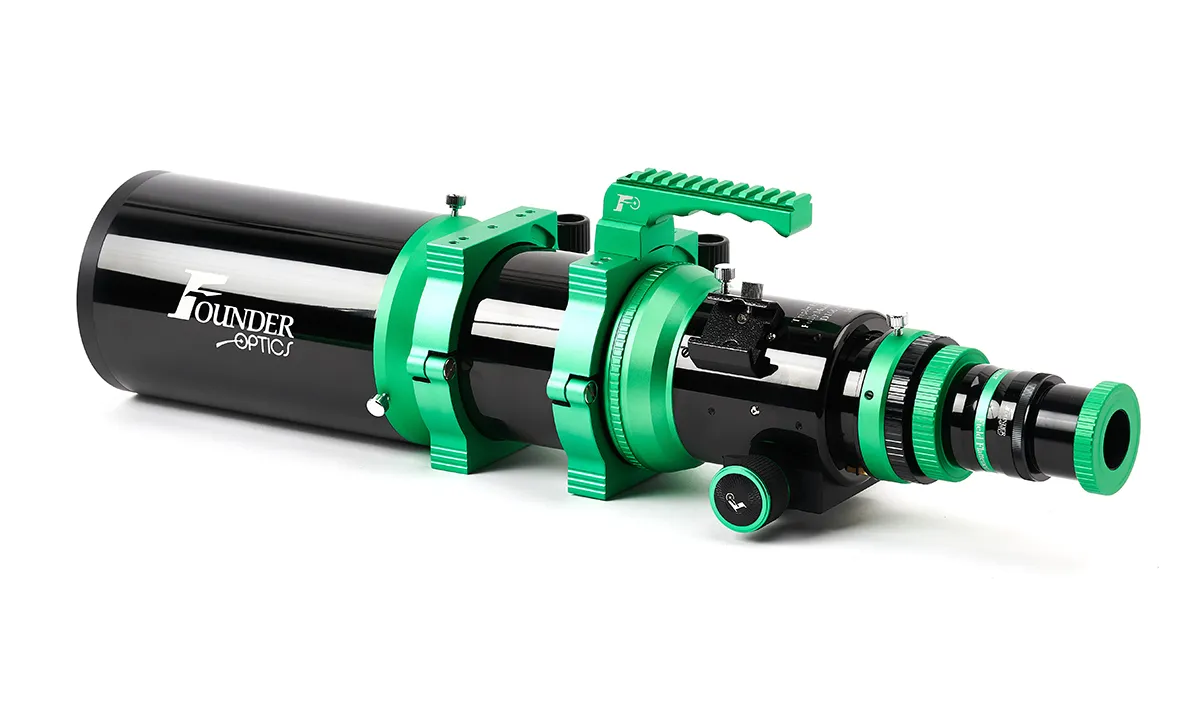
Although we could have enjoyed the rewards of visually observing the skies for much longer with the Founder Optics FOT16, we were conscious of the summer nights during our review period not being particularly dark or long, so we removed the visual astronomy accessories and attached the field-flattener to our DSLR camera T-Ring via the M48 adaptor option that is provided.
The owner’s manual states that the useful image circle, or circle of illumination, with the field-flattener in place is 44mm, something our full-frame DSLR would test to the limit. We photographed star-rich areas and looked carefully at the results.
Indeed, we found that the centrally placed stars were round and pin-sharp, as expected, while the star shapes towards the corners and edges of the image started to show the effects of coma, the stars becoming a little stretched and larger
As an estimate we would say that a crop of an area about 60–70% of the full-frame image size will leave acceptable star shapes, which should be just about right for DSLR and CMOS cameras with APS-C-size sensors or smaller.
With an impressive optical performance both visually and with a camera, the Founder Optics FOT106 may be the next telescope to claim its place among the ranks of esteemed Japanese-designed optical equipment.
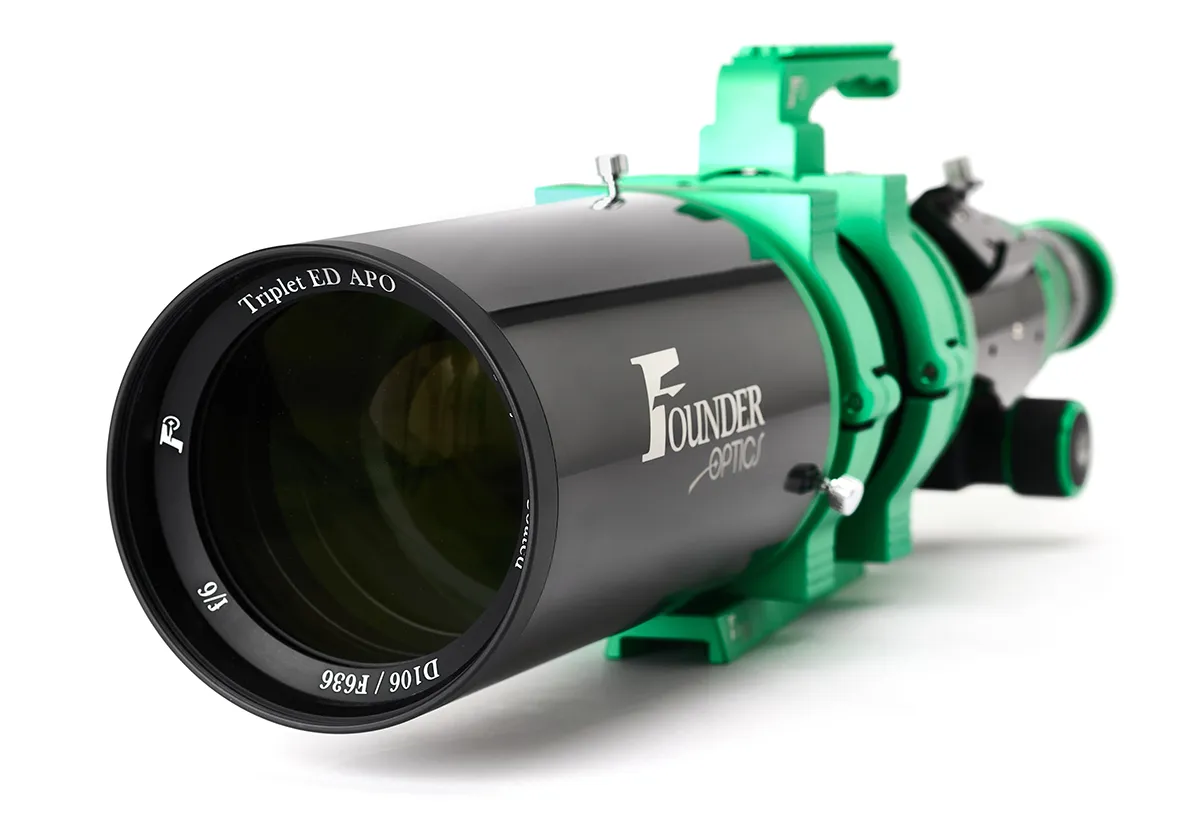
FOT106's objective lens
The FOT106 objective lens uses three distinct elements to achieve apochromatic colour correction, and two of these are made of extra-low dispersion (ED) glass, namely FPL-53 and FPL-51.
Fully multi-coated to minimise reflections, these lenses are separated by air-filled spaces, an approach to lens design also adopted by Takahashi TOA telescopes.
Of course, performance with an eyepiece or a camera is what really counts.
We viewed the bright edge of a near-full Moon at high power to check for any unwanted colour-fringing or haloes along the focused edge, an effect that can translate into coloured rings around bright stars in astro imaging, but the view was sharp and free of chromatic aberrations.
Although suitable photographic targets from our observatory were limited by the time of year, we were able to grab a series of images of the Dumbbell Nebula, Veil Nebula and Eagle Nebula.
With their tight, natural-coloured stars these images confirmed the impressive optical abilities of the FOT106.
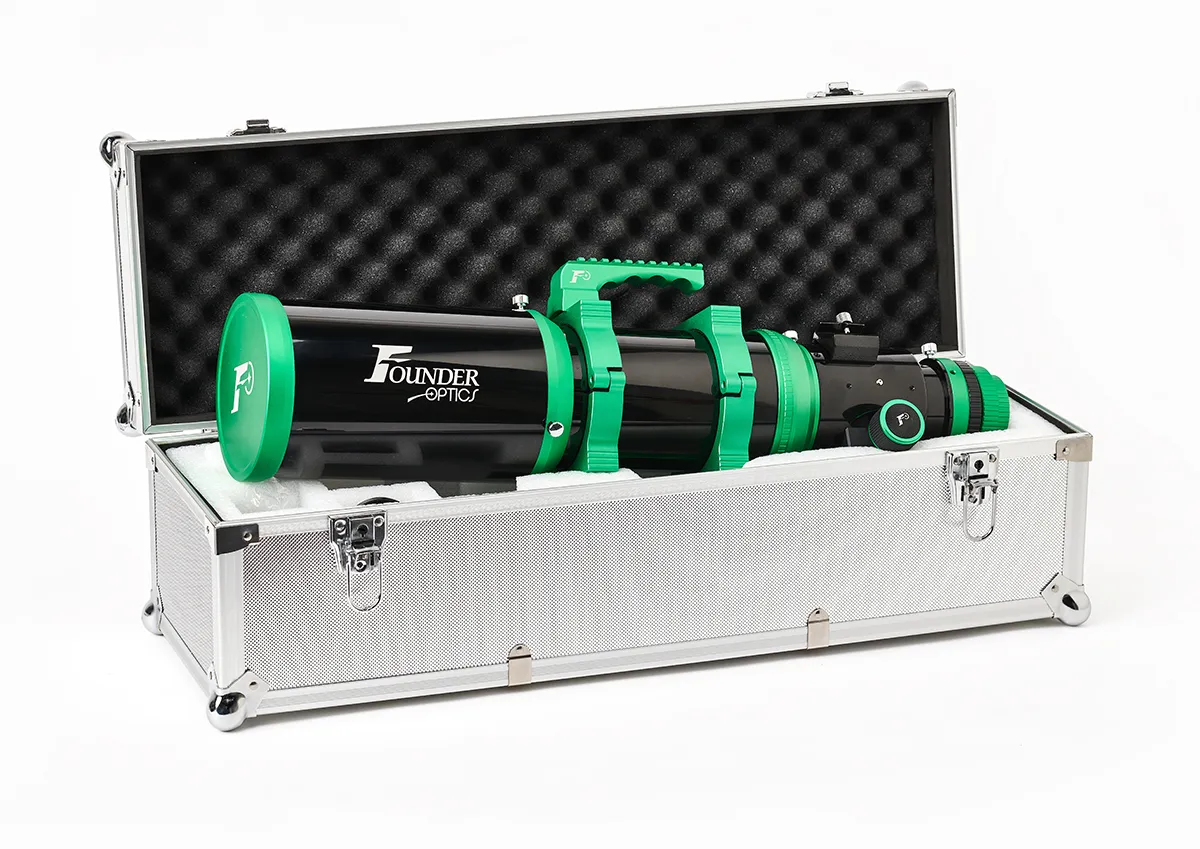
FOT106's outstanding features
1
Tube rings and carry handle
Stylish green tube rings and a Vixen-style mounting bar provide a solid link between the FOT106 and the mount. A custom carry handle bolts securely onto the top of the rings and incorporates a mounting rail for a red dot finder. All the necessary bolts are included in the package.
2
Owner’s manual and Inspection Report card
The underside of the focuser is stamped with a serial number, which matches that on the laminated Inspection Report and provides an individual verification of the scope’s optical and mechanical quality. The printed owner’s manual is a nice touch that gives tips on telescope-assembly, accessories and the correct use of the equipment.
3
Field-flattener
The inclusion of a matching field-flattener makes this telescope an almost out-of-the-box solution for astrophotography. It has a 2-inch nosepiece that is held firmly by the twist and lock collar on the focuser, and the M42– and M48–threaded adaptors for cameras offer a straightforward attachment to a CMOS camera or DSLR T-ring.
4
Focuser
The 2.7-inch focuser is a strong hybrid rack and pinion design, offering smooth, precise focusing with 1:11 reduction. Capable of holding 8kg, the drawtube is graduated and the whole assembly is easily rotated for comfortable viewing positions. In addition, the rear section rotates independently, allowing you to easily frame targets or quickly alter the positions of eyepieces.
5
Carry case
The foam-padded, locking carry case protects the telescope in transit or storage, holding the complete package conveniently together, including the field-flattener and rings. At just 70cm x 24cm x 23cm the case is very manageable and enhances the portability of the FOT106 while travelling, perhaps to darker skies.
Vital stats
- Price £2,159 package with field-flattener (or £1,999 OTA only; optional field-flattener at £179)
- Optics Air-spaced apo triplet
- Aperture 106mm
- Focal length 636mm
- Focuser Rack and pinion
- Extras Field-flattener, carry handle, lens cloth, Inspection Report and owner’s manual
- Weight 6.7kg (with tube rings; 5.5kg without)
- Supplier Widescreen Centre
- Tel 01353 776199
- www.widescreen-centre.co.uk
This article originally appeared in the September 2021 issue of BBC Sky at Night Magazine.
